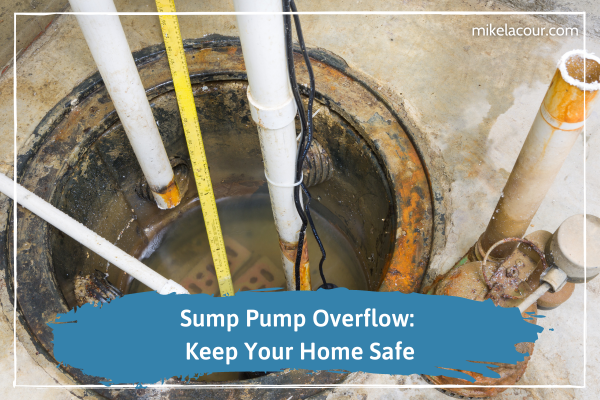Sump Pump Overflow: Are you familiar with sump pumps and their importance in keeping your basement dry? If so, then you probably know that a malfunctioning sump pump can lead to disastrous consequences, including costly property damage and potential health hazards. One of the most common issues that homeowners face with their sump pumps is overflow. This occurs when the pump fails to remove excess water from the pit, causing it to spill over onto your basement floor.
In this blog post, we’ll take a closer look at the causes of sump pump overflow and explore some effective solutions for preventing it. So, if you want to keep your home safe and dry, read on!


What is a sump pump and how does it work?
A sump pump is a device that helps to keep the basement of your home dry by removing excess water from the pit. It’s usually installed in a hole or basin, typically located in the lowest part of your basement, where water tends to collect.
The way it works is simple: when water enters the pit and reaches a certain level, the sump pump activates and starts pumping out water through a discharge pipe. This prevents flooding and keeps your basement free from moisture-related problems like mold and mildew.
There are two main types of sump pumps: pedestal and submersible. Pedestal pumps sit on top of a pedestal outside of the pit while submersible pumps are placed inside the pit itself.
Sump pumps can be powered either electrically or by battery backup systems. The latter is particularly useful during power outages or if your primary electrical system fails due to severe weather conditions.
Sump pumps play an essential role in protecting your home from costly damage caused by floods, heavy rainfalls, or other forms of excess moisture buildup.
Causes of sump pump overflow
Sump pumps are essential for keeping homes dry and free from water damage. But what happens when they fail to function correctly, and the sump pump overflows? There can be several reasons why this occurs.
One of the leading causes of sump pump overflow is a power outage. When there is no electricity, your sump pump cannot operate effectively, causing water to accumulate in your basement or crawl space.
Another common reason for sump pump overflow is an overwhelmed system. If you have heavy rainfall or melting snow, it can cause an excessive amount of water to enter the pit at once, which may exceed the capacity of your sump pump.
A malfunctioning float switch or stuck check valve can also lead to a sump pump overflow as they prevent water from flowing out properly. Additionally, if debris clogs up your discharge pipe or inlet screen, it could obstruct normal operations and result in an overflow situation.
Understanding these causes helps homeowners take preventative measures against potential overflows by performing regular maintenance on their systems.
Signs of a sump pump overflow
Signs of a sump pump overflow can be worrisome, but recognizing them early on can help prevent major damage to your home. One of the most obvious signs is when water starts pooling around the sump pump itself. This typically means that the pump has become overwhelmed and cannot keep up with the amount of water entering it.
Another sign of a potential sump pump overflow is when you hear strange noises coming from the pump or notice that it is running more frequently than usual. This could indicate that there is an issue with the motor or another component within the system.
A musty smell in your basement may also be a sign of a sump pump overflow problem. If water has been sitting stagnant for too long, mold and bacteria can start to grow and produce an unpleasant odor.
It’s important to keep an eye out for any changes in how your sump pump normally operates. If you notice any of these signs, it’s best to address them immediately before they turn into larger issues that require costly repairs or replacements.
The dangers of sump pump overflow
Sump pump overflow can be a major threat to your home and family. If left unchecked, it can lead to serious damage to your property, as well as pose a risk of electrical shock or fire. Here are some of the dangers associated with sump pump overflow:
1) Property Damage – Sump pump overflow can cause severe water damage to your basement or crawl space, ruining flooring, walls, furniture and other items in its path.
2) Mold Growth – Mold growth is another potential hazard that arises from sump pump overflow. This fungus thrives in damp environments and can cause respiratory problems for those exposed over time.
3) Electrical Shock – Water and electricity do not mix well together. A sump pump malfunction could lead to the possibility of electrical shock if you step into standing water.
4) Fire Hazard – An overloaded circuit caused by a faulty sump pump or improper wiring poses a risk for starting an electrical fire in your home.
5) Health Concerns- The health concerns related to stagnant water include bacterial infections such as E.coli, Salmonella etc., which leads to vomiting and diarrhea among people who come into contact with them even indirectly
To avoid these risks associated with sump pump overflow make sure that you have regular maintenance checks done on your system by professionals who know what they are doing!
Preventative maintenance for your sump pump
Preventative maintenance is crucial to keeping your sump pump in good working condition and avoiding overflow. Here are some tips for maintaining your sump pump:
First, make sure that the sump pump is always plugged into a properly grounded outlet. You should also periodically check the power cord for any damage or wear.
Next, inspect your sump pump’s discharge line regularly. This line carries water away from the foundation of your home and can become clogged with debris over time. Clearing any blockages will help prevent overflow.
It’s also important to keep an eye on the float switch, which triggers the sump pump when water reaches a certain level in the pit. Make sure it moves freely and isn’t obstructed by anything inside the pit.
Additionally, test your sump pump regularly by pouring water into the pit until it activates. If you notice any issues during testing, such as unusual sounds or slow drainage, call a professional for repairs.
Consider installing a backup battery system for your sump pump in case of power outages or other emergencies that could cause overflowing. A little preventative maintenance goes a long way in protecting your home from costly flood damage caused by sump pump overflow!
DIY sump pump overflow solutions
A sump pump overflow can be a homeowner’s worst nightmare, but luckily there are some DIY solutions that may help prevent it.
One of the most important things you can do is to regularly check your sump pump for any signs of wear and tear. Make sure that it is plugged in and functioning correctly at all times.
Another solution is to install a backup battery on your sump pump, which will ensure that it continues working even if the power goes out during a storm or other emergency situation.
If you notice water beginning to accumulate around your basement floor drain, this could be a sign of an impending overflow. In this case, try pouring hot water down the drain to see if it clears up the clog causing the backup.
Consider installing additional drainage systems around your home’s foundation or adding extensions onto your downspouts to direct rainwater further away from your home.
While these DIY solutions may work in some cases, they should not replace regular maintenance and professional inspections by qualified technicians. It’s always best to consult with experts when dealing with complex plumbing issues like sump pumps!
Professional sump pump overflow solutions
If you’ve tried DIY solutions and your sump pump is still overflowing, it’s time to call in the professionals. A licensed plumber or waterproofing specialist can assess your specific situation and provide customized solutions.
One option is to install a backup sump pump system, which will kick on if the primary pump fails or can’t keep up with water flow. This provides an extra layer of protection against overflow.
Another solution may be to add additional drainage systems such as French drains or exterior drain tiles around the perimeter of your home. These systems redirect water away from your foundation and into a designated drainage area.
In some cases, upgrading your existing sump pump may be necessary. A professional can recommend a higher-capacity pump that is better equipped to handle heavy rainfalls or other issues that are causing overflow.
Investing in professional help for your sump pump overflow issue can save you time, money, and headaches in the long run by ensuring proper installation and maintenance of effective solutions tailored to meet the unique needs of your home.
Benefits of sump pump maintenance and prevention
Regular sump pump maintenance and prevention can help save you thousands of dollars in potential water damage costs. By investing in the proper care of your sump pump, you can extend its lifespan and ensure that it continues to function effectively when needed most.
One of the biggest benefits of regular sump pump maintenance is that it helps prevent overflow. A well-maintained sump pump will be able to handle excess water without overflowing, which means less risk of water damage or flooding in your home.
Additionally, a properly functioning sump pump can help improve indoor air quality by reducing moisture levels. This makes it less likely for mold and mildew to grow, which can cause health problems for you and your family.
Regular maintenance also provides an opportunity to identify any small issues before they turn into big ones. Catching these issues early on allows for quick repairs or replacements, preventing major breakdowns that could lead to costly repairs or replacement later on.
Investing time and money into regular sump pump maintenance is a smart decision that pays off in the long run by protecting your home from potential water damage while improving indoor air quality.
Common mistakes to avoid with your sump pump
While a sump pump can save your home from water damage, it’s important to use and maintain it correctly. Here are some common mistakes you should avoid with your sump pump:
Firstly, make sure that the sump pit is large enough for the sump pump volume capacity. A small or poorly sized pit may cause premature wear and tear on the motor.
Secondly, never overload your electrical circuit by plugging in other appliances into the same outlet as your sump pump. Overloading can trip the breaker or create an electric hazard.
Thirdly, don’t forget to test your unit regularly! It’s crucial to ensure that everything works properly before a storm hits. Testing also helps detect any potential issues so that they can be fixed promptly.
Always choose suitable discharge pipes because incorrect sizing will lead to clogs and backups which will ultimately result in overflow of water onto your basement floor instead of being pumped outside where it belongs.
By avoiding these common mistakes when using and maintaining a sump pump, you’ll increase its lifespan while ensuring maximum protection against water damage during heavy rainfall events.
The importance of hiring a professional for sump pump maintenance
When it comes to sump pump maintenance, many homeowners may choose to take the DIY route. While this can save money in the short term, it can also lead to costly mistakes and potential safety hazards. That’s why it’s important to consider hiring a professional for your sump pump maintenance needs.
One of the main benefits of hiring a professional is their expertise and experience with various types of sump pumps. They know how each system works and what signs to look for that indicate issues or potential problems down the line.
Additionally, professionals have access to specialized equipment and tools that allow them to inspect every aspect of your sump pump system thoroughly. They can identify any underlying issues that may not be immediately apparent through visual inspection alone.
Another advantage is that hiring a professional ensures proper installation and repairs. Improper installation or repair work done by an untrained individual could result in further damage or inefficiency, costing you more time and money in the long run.
Professionals provide peace of mind knowing that your home is safe from any potential flooding threats caused by faulty sump pumps. With their knowledge and experience, they are equipped to handle any emergency situations quickly and effectively.
Investing in a professional for your sump pump maintenance needs ensures optimal performance while preventing future mishaps or disasters caused by neglect or lack of expertise.
Sump pump replacement options
When it comes to sump pump overflow prevention, sometimes a replacement is necessary. If your current sump pump is old or has been experiencing frequent issues, it might be time for an upgrade.
There are several options when it comes to choosing a new sump pump. The two main types of pumps are pedestal and submersible. Pedestal pumps have the motor located above the waterline and are often less expensive than submersible pumps, but they can be louder and less effective at pumping out large amounts of water quickly.
Submersible pumps have the motor located underwater which makes them quieter and more efficient at handling larger volumes of water. They also tend to last longer than pedestal pumps due to their waterproof design.
Another important factor when selecting a new sump pump is horsepower (HP). Generally speaking, higher HP means more power and faster pumping speed. However, you don’t always need the highest HP available – consider your specific needs before making a decision.
It’s also worth considering additional features like battery backup or WiFi connectivity for remote monitoring.
Ultimately, choosing a replacement sump pump will depend on your specific needs and budget. It’s important to do your research beforehand so that you can make an informed decision that will keep your home safe from potential flooding caused by sump pump overflow.
FAQs
Q: What causes a sump pump to overflow?
A: Sump pumps can overflow due to various reasons such as power outages, clogged discharge lines, faulty switches or float valves, and improper installation.
Q: How do I know if my sump pump is overflowing?
A: Signs of a sump pump overflow include water stains on basement walls, musty odors, excessive moisture in the air, and frequent cycling on/off.
Q: Why is it dangerous to have a flooded basement?
A: A flooded basement can lead to structural damage, mold growth which poses health risks like respiratory illnesses or even electrocution if electrical appliances come into contact with standing water.
Q: Can I fix my own sump pump problems?
A: While there are DIY solutions for minor issues like cleaning debris from the intake screen or replacing a malfunctioning switch/float valve; larger repairs should be left up to professionals.
By addressing these FAQs and providing helpful answers homeowners will feel confident about taking care of their sump pumps.
Conclusion
Sump pumps are a crucial component of your home’s plumbing system. They help keep your basement and crawl space dry by preventing water damage caused by heavy rain or melting snow. However, sump pump overflow can be dangerous if left unchecked.
It’s important to regularly maintain and inspect your sump pump to ensure it is working correctly. DIY solutions can be helpful in some cases, but it’s always best to hire a professional for maintenance and repairs.
Remember, prevention is key when it comes to sump pump overflow. By taking the necessary steps to maintain your sump pump and addressing any issues as soon as they arise, you can avoid costly damages and keep your home safe from flooding.






GIPHY App Key not set. Please check settings